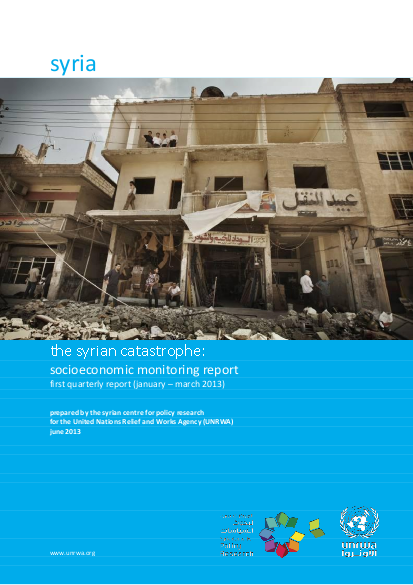First Quarterly Report (January – March 2013)

This report is the first of five quarterly reports commissioned by UNRWA from the Syrian Centre for Policy Research (SCPR). These aim to provide an on-going assessment of the socioeconomic landscape in Syria during the current crisis by using available official updates and utilizing econometric models to estimate other key indicators. These reports will provide a planning tool and framework for UNRWA, which will also be available to the UN system and interested parties, to build policies and programmes that look beyond the current humanitarian emergency toward relevant interventions to guide rehabilitation and development efforts for Syria.1 This report builds on the framework, methodology and analysis developed in the Centre’s earlier report on "Socioeconomic Roots and Impacts of the Syrian Crisis" that analysed the situation in 2012 (SCPR, 2013).
For more than two years, Syria has witnessed an internal armed-conflict that emerged out of a deep socio-political crisis. While the initial catalyst of the conflict appeared to be domestic, it has subsequently assumed debilitating national, regional and international dimensions, which now underpin a crisis of manifold complexity with manifest political, economic, and social consequences that will not be easily resolved either through diplomacy or warfare. Moreover, the armed-conflict is rapidly draining the human capital, productive assets and economic wealth of the country, while fostering violence and antagonism that is distorting social cohesion and diversity. The conflict has resulted in the diversion of resources from productive to destructive activity in an anti-social environment that is compounded by criminality, lawlessness and terror. The continuation of such trends throughout 2013 will have calamitous impact on the overall development in the country.
In estimating the short-term impact of the crisis during 2011, 2012 and the first quarter of 2013, this report uses the economic concept of ‘opportunity cost’ to determine the extent of economic losses.
The methodological approach is based on counterfactual procedures that compare the "crisis scenario", or the actual indicators during the crisis, with the "continuing scenario", or the indicators that would most likely have been achieved had the crisis not emerged. The gap between these two scenarios equals the socioeconomic losses attributable to the crisis. The report includes multiple macroeconomic and social performance indicators that were compiled and estimated based on official sources and in consultation with a large number of experts, and also by using several models, such as financial programming, within a comprehensive developmental framework. These indicators allowed the team to draw a relatively clear picture of economic trends in 2011, 2012 and the first quarter of 2013.